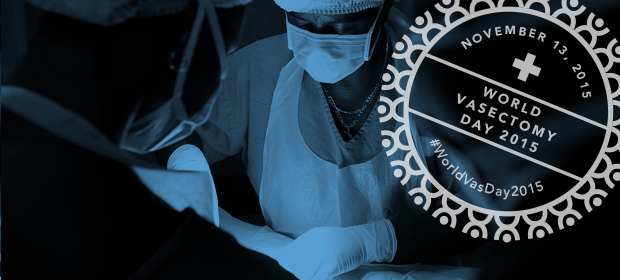Where We Work
See our interactive map


The unavailability of vasectomy services in low-income countries is a program issue and a gender issue. Here's how we can address it.
This post originally appeared in The Lancet Global Health.
Family planning programs in low-resource countries have notably expanded access to modern contraception. The modern method contraceptive prevalence rate (MCPR) is now 56% in UN-designated least developing regions (61% in developed regions). In least developed countries, the rate has risen from negligible proportions in the 1970s to 30% in 2011. A bedrock principle of family planning programs is to ensure individuals and couples seeking contraception are able to make a voluntary and informed choice from a wide range of methods to meet their reproductive goals. This principle was endorsed by 179 countries in the Programme of Action of the 1994 Cairo International Conference on Population and Development, and has been reiterated often. There is also longstanding international consensus on the importance of gender equity. From the standpoint of vasectomy (male sterilization), however, there has been a disconnect between stated commitments to choice and equity and program realities.
Quality vasectomy services can feasibly be introduced, scaled up, and, ultimately, sustained. This will require adequate time and resource commitment to address provider, client, and health system factors.
Almost all men are eligible to have a vasectomy. It is highly effective, convenient, and easy to provide, and is also, along with female sterilization, one of only two permanent methods of contraception. For these reasons, and to share contraceptive responsibilities, vasectomy is widely chosen in regions and countries with high socioeconomic development and gender equality. Vasectomy prevalence is 12% in the USA and Canada combined and 11% in Oceania and northern Europe. In Canada it is the most widely used method: 22% of women rely on vasectomy, accounting for 31% of all modern method use. The UK, New Zealand, and South Korea have similar profiles, with vasectomy prevalence ranging from 17% to 21%, comprising 24% to 27% of modern method use. Australia, Belgium, Denmark, Spain, Switzerland, and the USA also have substantial vasectomy use, with prevalence ranging from 8% to 11%. In the USA, 175,000 to 350,000 vasectomies are done every year.
The situation differs markedly in the world's 69 least developed countries: only 0.7% of women are able to rely on a partner's vasectomy. Vasectomy prevalence in Africa is 0.0%, with fewer than 100,000 men having accessed it. Of 54 African countries, only ten report measurable vasectomy use and only Swaziland (0.3%), Botswana (0.4%), and South Africa (0.7%) exceed 0.1% prevalence. Vasectomy is the least known modern method in most low-resource countries. Furthermore, the knowledge (or, more accurately, awareness) that does exist, among women and men alike, is often burdened by erroneous understandings that equate vasectomy with castration, impotence, and weakness (inability to work). When a man does desire vasectomy, skilled providers are generally unavailable to provide services. Although vasectomy is simpler to perform, less invasive, safer, and more cost effective than female sterilization, less than one in 11 users of permanent methods in developing regions relies on vasectomy.
From a woman's perspective in low-income countries, after having borne her desired number of children, and, typically, the lion's share of contraceptive responsibility, vasectomy can indeed be the kindest cut.
However, all is not bleak. As greater education and participation of women, rapid urbanization, and the spread of global communication continue to drive smaller desired family size in almost all countries, demand to limit future childbearing among married women continues to rise and now exceeds demand to space births in all regions except western Africa and middle Africa. The average age at which this occurs can be surprisingly low—e.g. 29 years in Malawi, 28 years in Namibia, 24 years in Lesotho, and 23 years in Swaziland. Female sterilization is the most widely used method worldwide, with 223 million women relying on it; another 28 million women rely on their partner's vasectomy. Malawi, one of the world's ten poorest countries, has achieved 9.7% female sterilization prevalence; more than 170,000 procedures were provided there from 2008 to 2011 via public–private partnerships, free mobile services, and family planning-dedicated, non-physician providers.
Thoughtful, male-centred programming has resulted in greater vasectomy use in Nepal (7.8% prevalence), Brazil (5.1%), and Colombia (3.4%). In Rwanda, pilot programs have provided more than 1,000 vasectomies annually.
What, then, needs to be done for vasectomy to become a routinely available, readily accessible method option in low-income countries? First, policymakers, donors, and program leaders and implementers must appreciate the current and likely future extent of demand for preventing future pregnancies. Second, they need to understand that quality vasectomy services can feasibly be introduced, scaled up, and, ultimately, sustained. This will require adequate time and resource commitment to address provider, client, and health system factors. Third, they need to appreciate that vasectomy unavailability is a gender issue as well as a program issue. Perhaps we can emulate Bhutan, known for its index—and achievement—of Gross National Happiness, and with a vasectomy prevalence of 13%, 19% of its overall MMCR of 65%. From a woman's perspective in low-income countries, after having borne her desired number of children, and, typically, the lion's share of contraceptive responsibility, vasectomy can indeed be the kindest cut.
Get the latest updates from the blog and eNews




